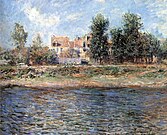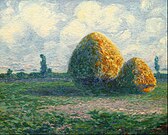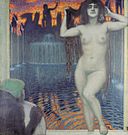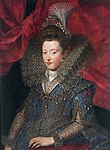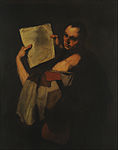Museo Nacional de Bellas Artes (Buenos Aires)
Museo Nacional de Bellas Artes | |
 Facade of the museum in 2017 Location within Buenos Aires | |
 Interactive fullscreen map | |
| Established | 25 December 1896 |
|---|---|
| Location | Avenida del Libertador 1473 Buenos Aires, Argentina |
| Coordinates | 34°35′2.6″S 58°23′34.1″W / 34.584056°S 58.392806°W |
| Type | Art museum |
| Director | Andrés Duprat |
| Website | bellasartes.gob.ar |
The National Museum of Fine Arts (Spanish: Museo Nacional de Bellas Artes) is an Argentine art museum in Buenos Aires, located in the Recoleta section of the city. The Museum inaugurated a branch in Neuquén in 2004. The museum hosts works by Goya, Rembrandt, Van Gogh, Rodin, Manet and Chagall among other artists.
History


Argentine painter and art critic
The museum was modernized both physically and in its collections during the 1955–64 tenure of director
The ground floor of the museum holds 24 exhibit halls housing a fine international collection of paintings from the Middle Ages up to the 20th century, together with the museum's art history library. The first floor's eight exhibit halls contain a collection of paintings by some of the most important 20th-century Argentine painters, including Antonio Berni, Ernesto de la Cárcova, Benito Quinquela Martín, Eduardo Sívori, Sarah Grilo, Alfredo Guttero, Raquel Forner, Xul Solar, Marcelo Pombo and Lino Enea Spilimbergo. The second floor's two halls, completed in 1984, hold an exhibition of photographs and two sculpture terraces, as well as most of the institution's administrative and technical departments.
Gallery
-
Flemish Baroque, Allegory of Fortune and Virtue, Rubens, 17th century
-
Dutch Baroque, Portrait of Young Woman, Rembrandt, 1634
-
Dutch Baroque, Landscape with the Ruins of the Abbey of Rijnsburg, Cuyp, 1645
-
Argentine naturalism, A Stop in the Countryside, Pueyrredón, 1861
-
French Impressionism, The Bridge of Argenteuil, Monet, 1875
-
French naturalism, Portrait of Ernest Hoschedé and his daughter Martha, Manet, 1876
-
French Impressionism, The Banks of the Seine, Monet, 1880
-
French academic art, The First Mourning, Bouguereau, 1888
-
Argentine naturalism, Interior view of Curuzú looked upstream, López, 1891
-
Argentine naturalism, The return of the malón, Della Valle, 1892
-
Argentine naturalism, After the Battle of Curupaytí, López, 1893
-
Argentine naturalism, Without bread and without work, Cárcova, 1894
-
French Impressionism, Dancers and Two Yellow Roses, Degas, 1898
-
Argentine Impressionism, The Haystacks (The Pampa of Today), Malharro, 1911
-
German symbolism, Batsheba,Stuck, 1912
-
Flemish Renaissance, The Birth of Virgin Mary, Oostanen, late 15th or early 16th century
-
Flemish Baroque, Portrait of Margarita Gonzaga, Pourbus (the Younger), 1603
-
Spanish Baroque, An astronomer, Ribera, 1617–1652
-
Spanish Baroque, Saint Francis in Meditation, Zurbarán, 1632
-
Mexican Baroque, The Conquest of Mexico. Table VIII, Gonzales, 1696/1715
-
Scottish academic art, Master Cathcart and Dog, Raeburn, 1810
-
Argentine naturalism, Portrait of Manuelita Rosas, Pueyrredón, 1851
-
French naturalism, The Surprised Nymph, Manet, 1861
-
French Impressionism, Le Moulin de la Galette, Van Gogh, 1886–1887
-
Argentine naturalism, The Maid's Awakening, Sívori, 1887
-
Argentine Post-Impressionism, The Presentation, Thibon de Libian, 1918
-
Argentine return to order, Annunciation, Guttero, 1928








